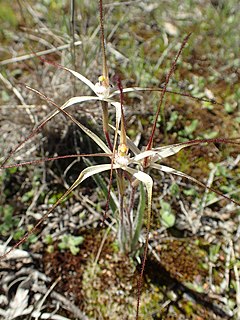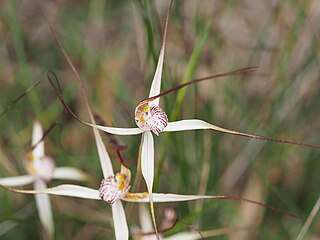Caladenia robinsonii, commonly known as the Frankston spider orchid is a plant in the orchid family Orchidaceae and is endemic to Victoria. It is a ground orchid with a single hairy leaf and one or two red and creamy-yellow flowers with dark red glandular tips on the sepals. In 2010 only about forty specimens of this plant, growing in a single population were known.
Caladenia colorata, commonly known as coloured spider-orchid, small western spider-orchid and painted spider-orchid is a plant in the orchid family Orchidaceae and is endemic to South Australia and possibly Victoria. It is a ground orchid with a single hairy leaf, and usually a single creamy-green flower with blood-red or purple-brown markings and with dark tips on the petals and sepals.
Caladenia dienema, commonly known as the windswept spider-orchid, is a plant in the orchid family Orchidaceae and is endemic to Tasmania. It is a ground orchid with a single, hairy leaf and a single, variably-coloured, usually dark red flower on a thin, wiry stem 5–12 cm (2–5 in) high.
Caladenia erythronema, commonly known as the red thread spider orchid, and Nyabing spider orchid is a plant in the orchid family Orchidaceae and is endemic to the south-west of Western Australia. It has a single hairy leaf and up to three red, yellow or cream-coloured flowers with dangling, thread-like sepals and petals and a small labellum.

Caladenia excelsa, commonly known as the giant spider orchid, is a species of orchid endemic to a small area in the south-west of Western Australia. It is a rare species with a single, hairy leaf and up to three cream-coloured to greenish-cream flowers with long, drooping sepals and petals. It is one of the tallest spider orchids in Western Australia and, with Caladenia splendens, has the largest flowers of any Western Australian orchid.

Caladenia filamentosa, commonly known as daddy-long-legs, is a plant in the orchid family Orchidaceae and is endemic to eastern Australia. It is a ground orchid with a single hairy leaf and up to four, usually dark red flowers with long, drooping lateral sepals and petals.
Caladenia flaccida, commonly known as the flaccid spider orchid, is a plant in the orchid family Orchidaceae and is endemic to eastern Australia. It is a ground orchid with a single hairy leaf and up to three cream-coloured, pinkish or red flowers with long, thread-like, glandular tips on the sepals and petals.

Caladenia fragrantissima, commonly known as the scented spider orchid, is a plant in the orchid family Orchidaceae and is endemic to Victoria and South Australia. It is a ground orchid with a single hairy leaf and up to three creamy-white to yellowish-green flowers. It is possible that it is conspecific with Caladenia orientalis.

Caladenia fulva, commonly known as the tawny spider orchid, is a plant in the orchid family Orchidaceae and is endemic to a small area in Victoria. It is a ground orchid with a single hairy leaf and one or two creamy-white to pale yellow flowers. Only two small populations are known, although both are in nature reserves.

Caladenia horistes, commonly known as the cream spider orchid is a species of orchid endemic to the south-west of Western Australia. It has a single, hairy leaf and one or two, creamy-yellow flowers which have a red-striped labellum and long, dark, thread-like tips on the sepals and petals.
Caladenia leptoclavia, commonly known as the thin-clubbed spider orchid, is a plant in the orchid family Orchidaceae and is endemic to New South Wales. It is a ground orchid with a single hairy leaf and a single pale cream-coloured to yellow flower with dark reddish stripes.
Caladenia meridionalis, commonly known as the south coast spider orchid, is a species of orchid endemic to the south-west of Western Australia. It is an early-flowering orchid with a single erect, hairy leaf and one or two white flowers with long, drooping lateral sepals and petals.

Caladenia orientalis, commonly known as the eastern spider orchid, is a species of orchid endemic to Victoria. It is a ground orchid with a single hairy leaf and one or two creamy-white to yellowish-green flowers and which only grows near the Mornington Peninsula.

Caladenia paradoxa, commonly known as the ironcaps spider orchid, is a species of orchid endemic to the south-west of Western Australia. It has a single erect, hairy leaf and up to three small creamy-white flowers. It was previously thought to be the same species as the eastern Australian Caladenia flaccida but is now recognised as distinct.
Caladenia patersonii is a plant in the orchid family Orchidaceae and is native to Victoria and Tasmania. It is a ground orchid with a single hairy leaf and one or two creamy-white, yellowish or pink flowers.

Caladenia pendens subsp. pendens, commonly known as the pendant spider orchid, is a plant in the orchid family Orchidaceae and is endemic to the south-west of Western Australia. It has a single hairy leaf and up to three relatively large, creamy-white flowers with long drooping petals and sepals and sometimes has a sickly-sweet scent.

Caladenia pendens subsp. talbotii, commonly known as Talbot's spider orchid, is a plant in the orchid family Orchidaceae and is endemic to the south-west of Western Australia. It has a single hairy leaf and one or two white, red and yellow flowers with long drooping petals and sepals and sometimes has a citrus-like scent.
Caladenia perangusta, commonly known as the Boyup Brook spider orchid, is a species of orchid endemic to the south-west of Western Australia. It is a rare spider orchid with a single hairy leaf and one or two cream-yellow or red flowers with narrow, drooping sepals and petals.

Caladenia polychroma, commonly known as the Joseph's spider orchid, is a species of orchid endemic to the south-west of Western Australia. It has a single erect, hairy leaf and one or two relatively large and colourful but smelly flowers.
Caladenia postea, commonly known as the dark-tipped spider orchid, is a species of orchid endemic to the south-west of Western Australia. It has a single erect, hairy leaf and up to three small, pale creamy-white flowers. It has a relatively late flowering period compared to similar spider orchids.










